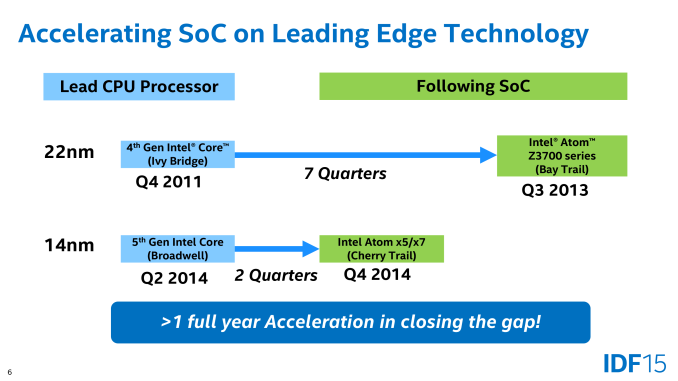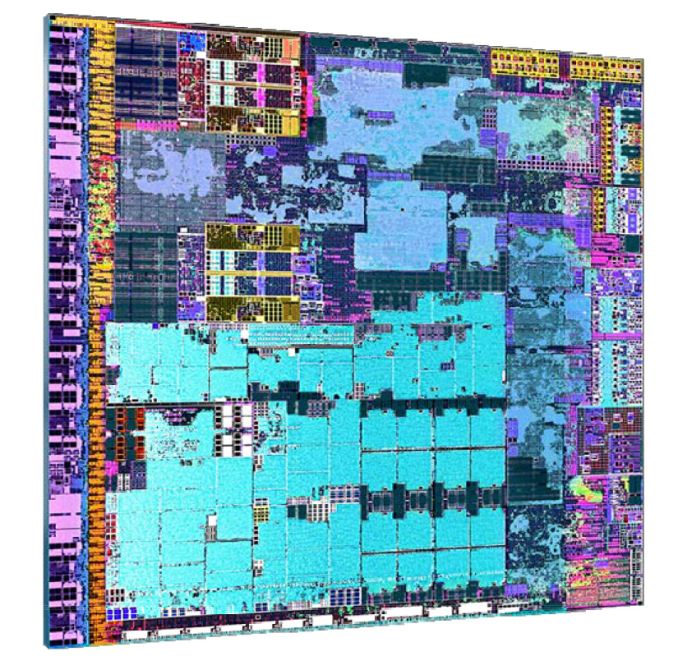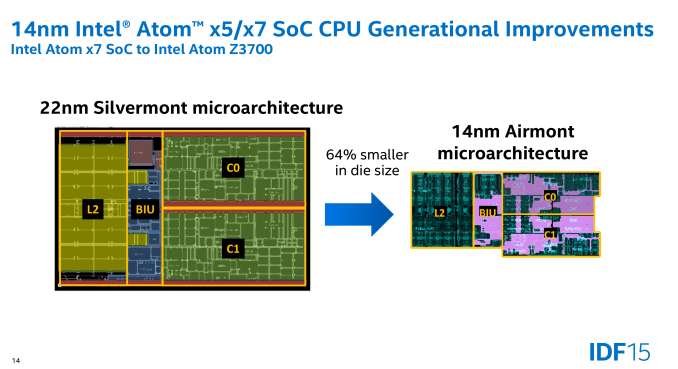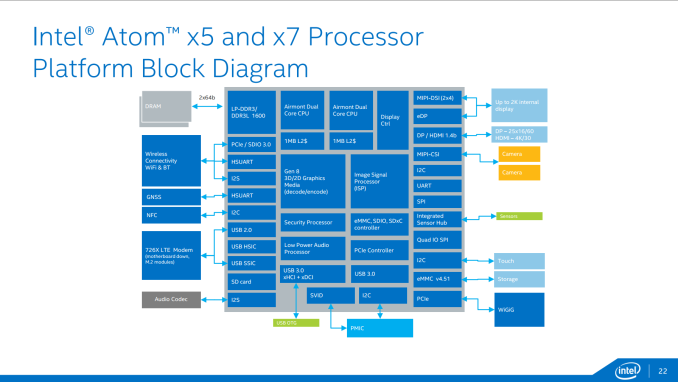The Surface 3 Review
by Brett Howse on May 4, 2015 9:00 AM ESTPowering the Surface 3: Intel’s Atom x7 System on a Chip
I still remember when back in 2011 Intel announced that they were finally going to stop treating Atom as a second class citizen at the manufacturing level, and bring it in line with the company’s mainstream Core processors. After having drawn out the 45nm and 32nm Atoms for too long, and suffering in the marketplace versus ARM as a result – Intel realized that to combat the growing threat of ARM they would need to treat the mobile market more seriously, and they would need to commit their sizable manufacturing advantage to the field to do this.
Now even Intel can’t turn on a dime – processors design begins half a decade in advance these days – so what have seen is a gradual ramping up towards this point. Silvermont, Intel’s first 22nm Atom, would introduce a more modern and better performing out-of-order architecture for Atom, meanwhile Intel would catch up on the manufacturing side by not producing 2 generations of Atoms on the 22nm node. Instead Silvermont would be the only 22nm Atom, and was to be followed by 14nm Airmont roughly a year later.
With Intel’s initial 14nm problems that year later ended up being a bit longer than a year, but in 2015 we’re finally there, and the change is remarkable. Only one generation ago, Intel launched their 22nm process as they always do, with desktop and high-performance laptop processors first. Now with 14nm the tables have been turned; Atom didn’t get first-dibs on 14nm – that went to Core M – but Airmont is still going to beat Intel’s desktop and high-performance Broadwell SKUs to the retail market. In one generation Intel has gone from favoring the desktop to favoring mobile, that’s how serious Intel has become.
That brings us to Surface 3, and the SoC powering it: Cherry Trail. The successor to the Silvermont-based Bay Trail that has powered so many x86 tablets in the last year, Cherry Trail is a distinct tick in Intel's tick-tock cadence. What this means is that Intel has largely retained the same architecture as in Bay Trail, investing in a fairly small number of updates, looking to take advantage of the power consumption and die size (cost) benefits of 14nm. To that end Intel has not even bothered to announce any major architectural changes for Airmont, and while there will likely be a few tweaks made to the CPU to make it work more efficiently on 14 nm, we will have to wait for Goldmont for the next big Atom architecture.
Cherry Trail itself is a fairly small chip. While Intel hasn’t released an official die size for it (no more than they did Bay Trail), from various IDF presentations they have released official numbers for the complete package, and decent photos as well. As a result we can take a decent stab at die sizes, and from Intel’s photos we’d estimate that the die size is around 83mm2. Unfortunately we don’t have anything quite comparable to Bay Trail, though we believe it to be a good bit smaller than Intel’s previous generation tablet SoC. At 83mm2 this would put the die size at quite a bit smaller than Apple’s A8X tablet SoC, and actually is just a hair smaller than the A8 phone SoC’s 89mm2.
Diving a bit deeper, Intel has also released some size data for individual Silvermont/Airmont CPU modules. The dual core modules, which contain the 2 CPU cores along with L2 cache and appropriate glue, have shrunk significantly from Silvermont to Airmont. Overall the Airmont CPU module is 64% smaller than the Silvermont module. And to be clear that does not mean Airmont is 64% of the size of Silvermont, that means that Airmont has been reduced by 64%; relative to Silvermont it is only 36% of the die size. Intel has achieved a better scaling factor than 22nm to 14nm alone, indicating that they have almost certainly enacted further optimizations to bring down the die size as an architectural level.
Moving on to the architecture of Cherry Trail, each Airmont core is a two-wide instruction decode with out of order execution. The L1 cache is 32 KB 8-way associative for instructions, and 24 KB 6-way associative data cache. Level 2 cache is 16-way associative with 1 MB of cache shared between two cores. There will be either two or four core versions available, which means that each SoC will have between 1 and 2 MB of L2 cache depending on the number of cores. There is no L3 cache on Atom.
The System on a Chip (SoC) has support for LP-DDR3 or DDR3L 1600 in dual-channel configuration, and has the blocks needed for PCIe 3.0, USB 2.0, USB 3.0, and support for up to three displays with eDP, DP, and HDMI 1.4b. The built in storage support is eMMC v4.5.1, which is typical for a tablet class processor.
Here is a Block Diagram of the SoC.
The one truely major change to the SoC is the inclusion of Intel's Gen 8 Graphics. Bay Trail used Gen 7 Graphics from Ivy Bridge, and Bay Trail only had 4 Execution Units (EUs) available. Cherry Trail ramps that up significantly, with the latest Gen 8 Graphics from Broadwell now onboard, bringing forward Intel's GPU enhancements over the last two half generations, not to mention the compute enhancements as well.
In terms of execution hardware the x7-8700 model has 16 EUs available, indicating that Intel has spent a significant amount of their die size savings from the 14nm process on graphics resources. Gen 8 has eight EUs per sub-slice but a minimum of three sub-slices in the design, and therefore in order to improve SoC yields the thread scheduler will dynamically allocate the right amount of cores per-subslice to total 16. For comparison, Intel's Broadwell line of Core processors have a minimum of 23 (but most have 24) EUs available, and a maximum of 48, so with Cherry Trail Intel has closed the top-to-top gap in execution resources between Core and Atom to just 3-1.
In Intel’s datasheets, the Atom GPU is labeled as Gen8-LP to designate that this is a low power model being used in a tablet. The base frequency for this GPU is 200 MHz, with a boost of 600 MHz.
In addition to the GPU update, the ISP and hardware decode capabilities get a bump as well. There is full hardware acceleration for decode of H.263, MPEG4, H.264, H.265 (HEVC), VP8, VP9, MVC, MPEG2, VC1, and JPEG, as well as hardware encode for H.264, H.263, VP8, MVC, and JPEG. This marks the first Intel product to ship with the company's full, fixed-function HEVC decoder, making Atom the company's most advanced media processor, at least for this short moment.
The overall SoC is 17mm x 17mm, and the Z-height is 0.937mm, so it is quite a bit smaller than Core M’s 30mm x 16.5mm x 1.05mm package. Intel is not listing a Thermal Design Power for the Atom chip, but is instead listing it as a Scenario Design Power of 2 watts. The CPU base frequency is 1.6 GHz with a turbo frequency of 2.4 GHz, and there is also support for a Low Frequency Mode of just 480 MHz for extra power savings when needed.
| Atom x7-8700 | Atom Z3785 | |
| Architecture | Cherry Trail (Airmont) | Bay Trail (Silvermont) |
| Cores / Threads | 4 / 4 | 4 / 4 |
| Base Frequency (MHz) | 1.6GHz | 1.5GHz |
| Turbo / Burst (MHz) | 2.4GHz | 2.4GHz |
| L2 Cache | 2 MB | 2 MB |
| SDP | 2 W | 2.2 W |
| GPU Architecture | Gen 8 | Gen 7 |
| GPU Execution Units | 16 | 4 |
| GPU Frequency / MHz | 200-600MHz | 313-833Mhz |
| DRAM | LPDDR3-1600 | LPDDR3-1333 |
So what we really have here is a massaged Bay Trail class chip, but the 14 nm process should allow for a higher period of sustained turbo frequencies to help out with performance. It will be interesting to see what Intel does with Goldmont, and if they will add things like hyper-threading or not, but that discussion is for another time.
















265 Comments
View All Comments
TremecsSTi - Friday, May 29, 2015 - link
I just found there is a very large elephant in the room that in 259 comments nobody has brought up.I had read this review and was still on the fence about what to buy but was leaning toward the iPad Air 2.
I went in to the store determined to walk out with an iPad Air 2 if nothing else so I could learn the ecosystem (This is my 3rd attempt to do so but I always balk at the cost of Apple products).
After picking up both tablets and comparing them the weight difference did not bother me as much as I thought it would. The 128/4 gb Surface 3 was $599, the 64/2 gb iPad Air 2 was $589.
Looking at the lack of ports on the iPad I started looking at accessories to be able to connect it to everything, $30 to hook it up to my monitor, $20 to hook up my camera, $30 to hook it up to my TV, $89 for a keyboard, $69, for a mouse! $829 for the iPad Air 2 and I did not even get to the covers. So I am typing this from my $718 Surface 3 ($599 + the $119 type cover) with double the ram and double the storage, micro USB, Micro SD, USB, Micro HDMI built in.
Looks like Apple lost out again but I just cannot justify the cost versus what you get. The quality of Apple products is hard to beat but the Surface 3 is very close and with twice the storage and ram for less money I could not pass it up.
blackcrayon - Saturday, May 30, 2015 - link
The Surface 3 looks like it's only about half as powerful as the GPU in the iPad, I guess if you aren't doing anything graphically intensive (games) it won't matter... Otherwise I cringe at the idea of trying a 3D game that's expecting what's normally available on Windows (i.e. Windows games aren't going to be optimized to run on such a slow GPU).khanikun - Wednesday, June 24, 2015 - link
You do know that Windows does everything a tablet does and did it before tablets were on the market? Also anyone who's invested money into any platform will have a hard time moving off that platform to another completely different platform.As for mixed bag, it's an all-in-one type device. Every single all-in-one type device has compromises. I don't have the Surface 3, but I do have the Surface Pro 3. Works great as both a tablet and as a notebook, so long as you don't actually want to use it in your lap. That's the only real downside that I find.
Now, for the Surface 3, I find it being more of a resurgence of netbooks, except in an all-in-one tablet like device. A device that can do it all, albeit not great, but well enough. Not to mention it does it not quickly, as it uses cheap internals, to keep costs down. The problem with this is the fact that MS gave it cheap internals, but decided to build a quality chassis with quality accessories. So the price point was brought down, but not down enough to satisfy everyone's wants. Sure, MS could have built this thing in a cheap plastic chassis and provided no keyboard or stylus option at all and left consumers to fend for themselves and this would have brought the price down below that of less functional iOS/Android tablets, but this would have also infuriated many consumers.
Really though, I find that MS did this right, minus the keyboard. The price point isn't unreasonable, when compared to less functional iOS/Android tablets. It's size and weight is well below that of convertible laptops. I just dislike the keyboard. Not it's feel or function, just that when you set it up in it's elevated position, it makes using the taskbar via touch, downright useless. I find myself having to remove it from the elevated position to access the taskbar via touch or use the crappy touchpad.
Ferrr - Wednesday, December 2, 2015 - link
I have a Surface 3 LTE, purchased in October 2015 with all updates duly installed. On the screen appear random clicks, like if I was touching it (but I don't) at full speed, making appear menus, opening files, starting apps etc. making the device unusable.I had reset the device to no avail.
Additionally, I experienced other problems:
- "Autorotate on" appears on the screen when working with the keyboard attached (so, not rotating at all) stopping the device for some seconds.
- A full charge needs 5-6h, with the device plugged in and switched off. If you want to work while charging the device, you will have a hard time: it charges extremely slowly (12h minimum needed) and in most of cases, if you have 2 or 3 "normal" (not very high energy consuming) apps open at the same time (outlook, word, edge), the device will keep on discharging, even plugged in.
- The device loses battery when on sleep mode at a very alarming pace (around 5% per hour)
I purchased the device in the US and I work in Russia. Now, with a worldwide guaranty, and in spite of having a filial in Russia, Microsoft asks me to ship the device, to pay for the shipping, to be delivered the new one in the US, and to pay the shipping again to my home in Russia...
And the screen problem is known since 3 years, with thousands of people complaining on forums.
Shame to Microsoft to keep on selling these crappy devices.
If you don't know how to make computers and how to deal with customers, please stay away and let others like Apple do that.
I deeply regret the day when I entered the Microsoft store to buy this.
Someone else is experience the same ordeal?
q8wii - Friday, February 19, 2016 - link
Thank you